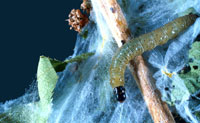Archips cerasivorana
Hosts
Choke cherry, Hawthorn, Rose, Wild black cherry and other hardwoods
Appearance and Life Cycle

Photo credit: Thérèse Arcand, Natural Resources Canada
The insect is named after its untidy, nest-forming characteristics. Larvae of the ugly nest caterpillar hatch from overwintering eggs in the spring and may be found feeding throughout May to September. The larvae are yellowish to greenish-yellow with black heads and thoracic shields and range from 20-23 mm in length when full grown. The larvae pupate within the nest during mid-June to September. The pupae move to the outer wall of the nest just before the adults emerge. Adults are orange moths with wingspans of 18-25 mm. The forewings are speckled and spotted with dark, reddish-brown markings. The hind wings are a solid, bright orange colour. The moths may be present from early July to September, depending on the climatic region. The females deposit their overwintering egg masses on the stem near the ground of host trees. There is only one generation a year of ugly nest caterpillar.
Damage

Photo credit: Natural Resources Canada
In the spring, the larvae construct a nest of leaves and branches that are tied together with dense webbing. The larvae feed as a group within the nest, enlarging the nest when necessary. The nest is often filled with excrement and bits of leaves, resulting in an unsightly mass. Damage caused by the ugly nest caterpillar has no lasting effect, but the presence of the nests reduces the aesthetic value of the tree. In severe cases, whole shrubs have been entirely covered by unsightly webbing. Outbreaks of the ugly nest caterpillar are sporadic and may be absent for several years.
Control
Chemical control of the ugly nest caterpillar is rarely required. In most cases, control can be achieved by cutting out and destroying the nests containing the larvae.